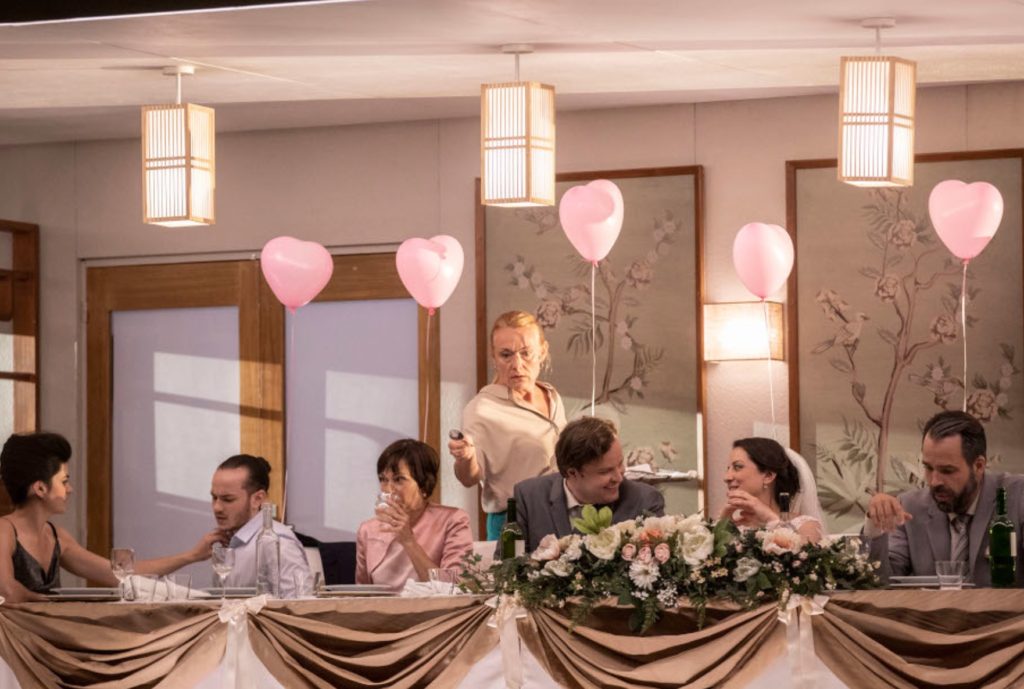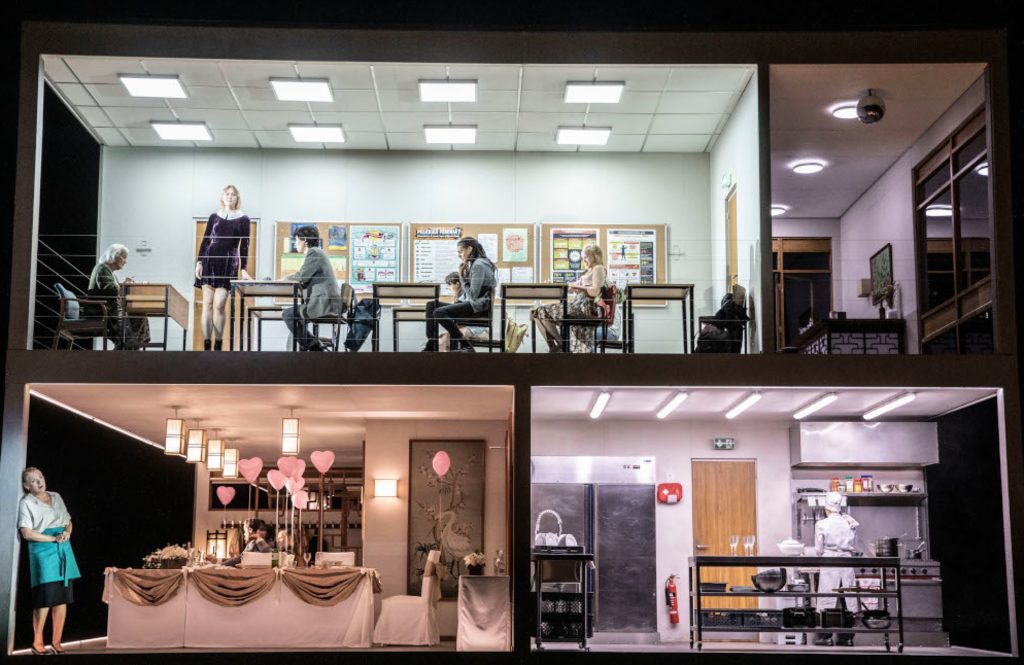DIGITAL REVIEW — Kaija Saariaho creates dream worlds unlike any composer since Debussy, with saturated harmonies often augmented by an underlying electronic music track, creating a landscape where disparate musical events are positioned with quietly insinuating power at times or erupting into operatic cataclysms at others. These gardens of sound — with microtonal haze, muted trumpets, and woodwind trills — always have dark undercurrents, though never darker than in her complex new opera Innocence, premiered to great acclaim and in grand, fully realized form July 3 at Festival Aix-en-Provence. It’s now available for streaming through Sept. 7, 2024, on Arte.tv, where I’ve watched it multiple times for lack of a plane ticket to France.
Musically, Saariaho is very much her dreamy self but in ways that are radically re-contextualized in dramatizing a highly realistic nightmare about a student who suddenly opens fire in a Helsinki high school. Yes, significant Columbine parallels are here. But why should this story be an opera, as opposed to a film or extended news report? As one friend observed, the opera creates an aura of urgency and horror that facts can’t touch.
For the 13-character drama, Saariaho had her mind’s eye on The Last Supper (according to a New York Times interview). The iconography is in no way manifested in the opera or its staging but perhaps accounts for a sense of inevitability in the flashbacks to the shooting, which is never actually seen but whose immediate aftermath is indeed documented.
The action in the Sofi Oksanen libretto (translated into something like seven intermingling languages by Aleksi Barrière) starts 10 years after the tragedy with characters including a still-grief-stricken waitress (sung by Magdalena Kožená) whose daughter was among the fatalities. She finds herself pressed into service at a wedding party that happens to be thrown by the killer’s family. Even more awkward, the groom and his parents haven’t shared this history with the beautiful young bride from Romania: They’re longing to be known on their own terms rather than as people who raised a murderer. But past and present is fluid in Saariaho operas, and thanks to Chloe Lamford’s compartmentalized multi-room set (that revolves), the opera tells the wedding party’s story chronologically but interwoven in with pockets of memory, plus ghosts telling long-hidden secrets.
The shooting is revisited halfway through the opera, and only then do the flashbacks start to explore what kind of psychology was leading up to the tragedy. The teacher (Lucy Shelton) berates herself for not for seeing the the tragedy coming, even though she had analyzed the students’ handwriting. Wrong place to look. In the cafeteria and shower room, the killer-to-be was being shamed, bullied, abused, and videoed. The killer’s mother (Sandrine Piau) even claims the abusers, later targeted by the killer, played a part in provoking the gunman. Ultimately, as everyone ends up lost and alone, the characters are forced to stop blaming and turn the page. Let me go, says one blood-stained child ghost in the final moments.

That’s a lot of plot for a 110-minute opera, especially in contrast to Saariaho’s dramatically expansive L’amour de loin. The directness of Innocence is blunted somewhat by the near-constant language shifts (ostensibly because the setting is an international school). Amid this, Saariaho has developed an unerring sense of word declamation in which characters talk (mostly young students), sing (adults), or do something in-between, such as the teacher’s Pierrot Lunaire-style Spechstimme, in which her billowing vocal lines seem to be buffeted by the strong emotions at hand. Male characters slip into a precarious falsetto in particularly intimate moments.
An otherworldly unseen chorus — sometimes male, sometimes female — might be ghosts or voices inside the heads of the characters. One remarkable concerted passage has seven characters, all with their own way of vocalizing words, interwoven in ways that almost seem like a musical crown of thorns. Perhaps a distant reference to the Christ imagery in Saariaho’s head? Within a score with such a wide expressive range, the vocal writing in more conventional solo narrative moments (every major character has his or her aria moment) possesses the freedom to do whatever is dramaturgically necessary.
While story and surface emotions unfold onstage, a cold, hard reality is psychologically characterized by the orchestra, which keeps very busy creating sound worlds for individual characters and conveying the prevailing zeitgeist. The score may be the most dense Saariaho has written, and the most atonal, almost by default: With so many elements in play, any tonal allegiances in one layer of the score tend to cancel out key centers in another.
The Act I prelude alone is like a concerto for orchestra with short instrumental solos, such as trilling woodwinds and intriguing piano writing that seems to be racing backward, forward, up, and down — and surrounded by driving polyrhythms. The effect is like an Escher print in sound. As tragedy approaches, the tipping point is conveyed with unsettling microtones giving way to metallic pile-driver rhythmic sonorities.
The whole package has amazingly few loose ends, with the London Symphony Orchestra and Estonian Philharmonic Chamber Choir under Susanna Mälkki confidently projecting the score and Simon Stone’s staging, which is no doubt engaging in the theater, making an admirably cinematic effect on screen. While some recent socially conscious operas have used tabula-rasa-style imagery to encompass a wide range of meaning, Innocence is more aggressively communicative — and particularly so on screen.
Voice and theatrical presence was seamless in most of the cast. Beautiful singing in such a drama-heavy contemporary opera is perhaps too much to hope for, but this is not some Thomas Adès voice wrecker. The main evidence is Kožená’s warm tone and fundamentally lyrical manner amid the anguish. Sandrine Piau wasn’t the best vocal fit in the role of the killer’s mom, but I hardly noticed at first, so convincing was her overall characterization. In fact, she somehow made herself seem to age 10 years as her character’s breezy confidence crumbled.

Similarly, the young Romanian bride (Lilian Farahani) is sparkling in the early scenes, but once she knows that she has been deceived in this deeply fraught situation, a change of posture makes her look heavier and weary. Obviously, such details are more apparent on screen than in the theater, which particularly benefited smaller but crucial roles.
The waitress’ deceased daughter is sung by Vilma Jää, whose voice sounds like such a cry from another world — in fact, she is a Finno-Ugric folklore specialist — that you really want to pair a close-up face with this singular voice. Julie Hega, who plays the killer’s confidant, handles her speeches with some of the most beautifully articulated French in the cast but speaks more volumes with her all-knowing facial expressions and general demeanor.
So much up-close precision coupled with the opera’s already specific dramaturgy gives Innocence a power that stays with you for days. And with a score that only suggests what to feel rather than what to think, the opera opens up different doors of understanding with every encounter. And it will be encountered: The Metropolitan Opera is named in partnership among co-commissioners that include the Royal Opera, Finnish National Opera, San Francisco Opera, and Dutch National Opera.